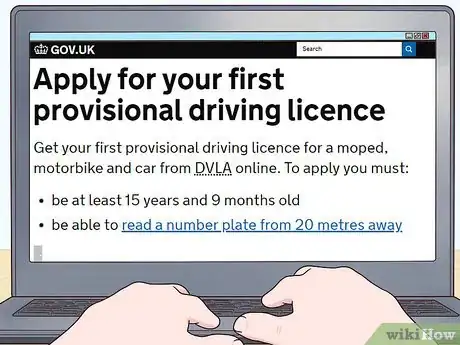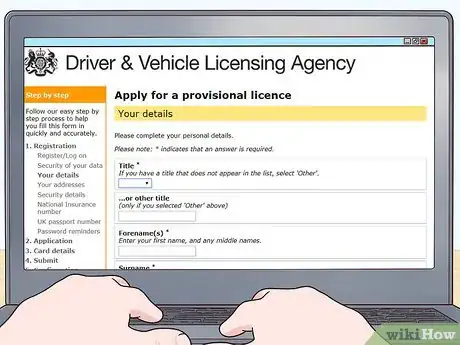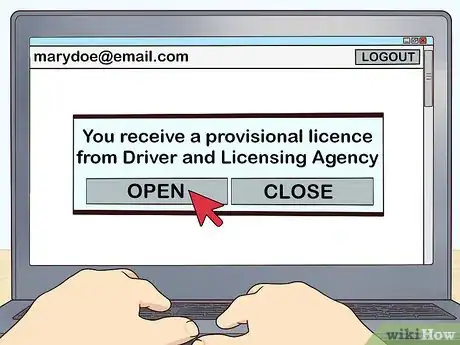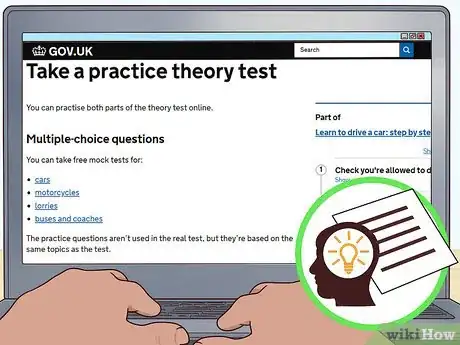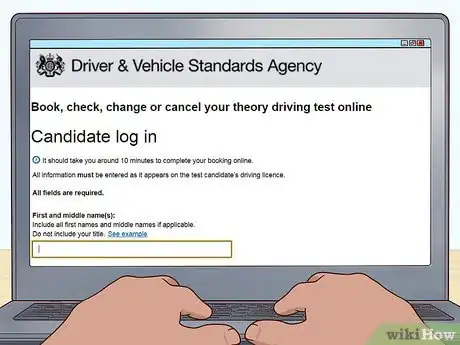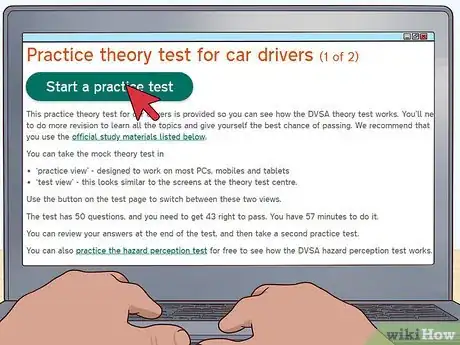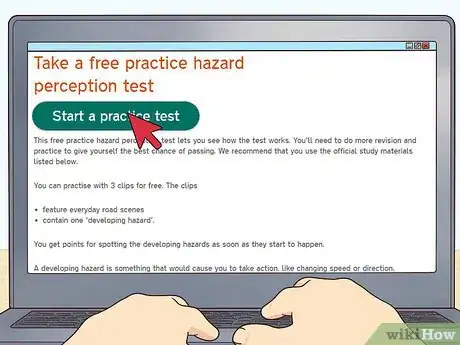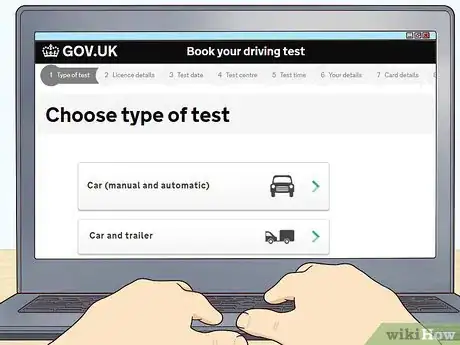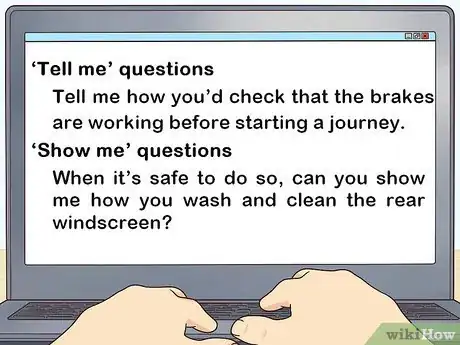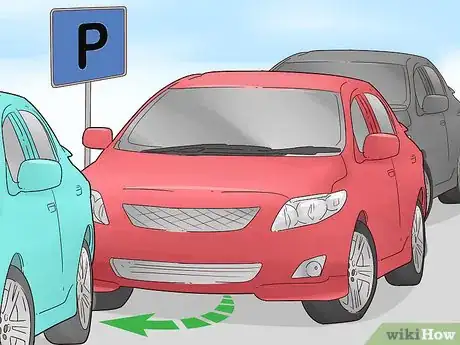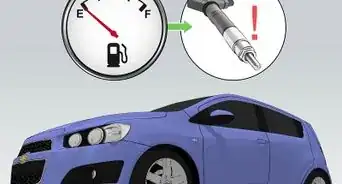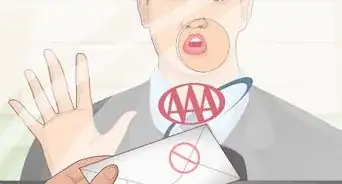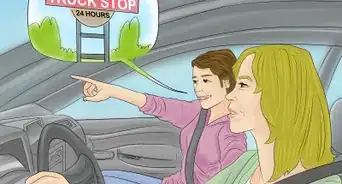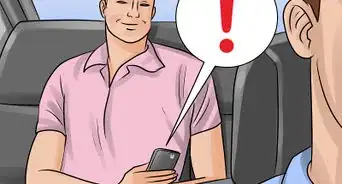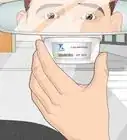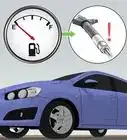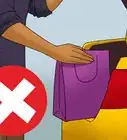This article was co-authored by Jacqueline Regev. Jacqueline Regev is a Driving Instructor and the Founder & CEO of Bubble of Safety Driving School. With over 20 years of education experience, she specializes in encouraging people to develop their skills to become safe and courteous drivers. Jacqueline earned a Bachelor's Degree from UCLA and an MA from Chapman University. She is also pursuing a PhD from UC Santa Barbara.
There are 17 references cited in this article, which can be found at the bottom of the page.
This article has been viewed 45,814 times.
Getting your driver’s licence can be a fun and exciting experience! Being able to drive opens a whole world of possibilities and new beginnings. To successfully earn your licence in the United Kingdom, you’ll need to apply for a provisional licence, pass a theory test, and pass your driving exam. Once you do, you can hit the road and see the world!
Steps
Applying for a Provisional Licence
-
1Meet the basic age and vision requirements. To apply for a provisional driving licence, you must be at least 15 years and 9 months old and be able to read a number plate from 20 metres (66 ft) away. Try testing your vision at home with the number plate on a friend’s or family member’s vehicle.[1]
-
2Gather your Identity documents. Identity documents include the following: a current passport, biometric residence permit, European Union or European Economic Area identity card, a recent bank or building society statement with your National Insurance number (if you are a pensioner), a birth, adoption, or naturalization certificate, a photocopy of the front page of your benefits book or an original benefits letter, a marriage certificate or divorce papers, or a college or university union card, education certificate, or PASS proof of age card.[2]
- If your name has changed, you should also include your marriage or civil partnership certificate, a deed poll, or a statutory declaration.[3]
- If your gender has changed, you should also include a deed poll, statutory declaration, or your gender recognition certificate.[4]
- You must include an original identity document (unless you have a valid UK biometric passport) and a colour passport-style photograph with your application.
- Your identity document and photograph must be signed by a UK resident with a valid photocard driving licence.[5]
- The person signing your document and photograph should be one of the following: a businessperson, librarian, lawyer, teacher, engineer, police officer, bank or building society member, civil servant, religious minister, magistrate, local councillor, or member of Parliament.[6]
Advertisement -
3Apply for your provisional licence online. You can apply for your provisional licence online. Once on the application website, you’ll need your Government Gateway ID, an identity document (unless you have a valid UK biometric passport), a list of the addresses where you’ve lived for the last 3 years, and your National Insurance number (if you know it). With all of this information, you’ll be able to fill out your application.[7]
- There is a £34 application fee for using the online system. The system accepts MasterCard, Visa, Electron, Maestro or Delta debit or credit card.[8]
-
4Apply by post as an alternative to the online application. You can also apply by post by filling out form D1 (available at the Driver and Vehicle Licensing Agency or certain branches of the post office).[9]
- There is a £47 fee that must be paid with a cheque or postal order made payable to the Driver and Vehicle Licensing Agency.[10]
- Send your application to DVLA, Swansea, SA99 1AD (if all your documents are from the UK) and DVLA, Swansea, SA99 1AF (if any of your documents are from outside the UK).[11]
-
5Wait for your provisional licence to arrive before driving. If you apply online, you should receive a confirmation email after you submit your application and your licence should arrive within 1 week. If you applied via post, your licence could take up to 3 weeks to arrive. Do not drive before you’ve received your licence.[12]
Taking the Driving Theory Tests
-
1Study for the theory exams. The theory exams are based on 3 books: The Highway Code, Know Your Traffic Signs, and Driving: The Essential Skills. You can purchase these books online or at any high street bookshop. You should also purchase the official guide to hazard perception, which can be found online for PC or Mac, on the Google Play Store or App Store for tablets and phones, or at any high street bookshop.[13]
- The theory exam may ask you questions about what different traffic signals mean, where a child under 11 should sit in your car, how to pass a motorcycle, how to turn from a major onto a minor road, and many other topics.
- You can also take the online practice theory tests by visiting https://www.gov.uk/take-practice-theory-test.
-
2Book your theory test. You can book your theory test online by visiting https://wsr.theorytest.direct.gov.uk/testtaker/signin/SignInPage/DSA?locale=en_GB. You’ll need an email address to do so; if you don’t have an email address, you’ll need to book your test by phone. You can find contact information and testing locations by visiting https://www.gov.uk/government/organisations/driver-and-vehicle-standards-agency/about/access-and-opening.[14]
-
3Pass a 50-question multiple choice test. You will have 57 minutes to complete your test and you will need to answer 43 questions correctly to pass. The questions will deal with anything from driving regulations, to road signs, to vehicle safety. Some of the questions may relate to case studies (short stories based on real-life situations).[17]
- Your practice tests and study guides will include all of the information you may face during the test.
-
4Pass the hazard perception test. Before you take your hazard perception test, you’ll be shown a video explaining how the test works. Then, you’ll be shown 14 video clips featuring everyday driving situations that have at least 1 hazard situation. To identify the hazard situation, you must click the mouse as soon as you see the hazard developing.[18]
- The hazard perception test may include developing hazards like pedestrians getting into a car in an unexpected place, vehicles unexpectedly reversing from a side road onto a main road, heavy goods vehicles obstructing your view, parked cars obstructing traffic, and many more.[19]
- The sooner you click the mouse after you identify the hazard, the higher the score you will receive. You can earn up to 5 points for each correctly identified hazard.[20]
- You will only get one chance to guess during each video. You won’t be penalized for getting an answer wrong, but if you click continuously or in a pattern you won’t earn any points.[21]
Taking the Practical Driving Exams
-
1Practice driving with an eligible friend, family member, or driving instructor. The Driver and Vehicle Licensing Agency recommends that you utilize an approved driving instructor, but you can also practice driving with a friend or family member that is at least 21 years of age and has had their driver’s licence for at least 3 years. You must have an “L” on the vehicle to drive. You can practice driving at any time of the day or night.[22]
- Testing anxiety affects people in various settings. It may be in the workplace, classroom, or a driving exam.
- If you want to take a driving exam, prepare by previewing the testing area and instrument.
- Practice with someone to have a mock experience of what it will feel like when the examiner sits next to you in your car.
- You can purchase an “L” plate online or at a local store like Halford’s or Wilkinson’s.[23]
- You can find an approved driving instructor, by visiting https://www.gov.uk/find-driving-schools-and-lessons.
-
2Make an appointment for your practical driving exams. You must be at least 17 years of age to drive in the United Kingdom, so you’ll need to wait until then to make your appointment for your practical driving exams. To make your appointment, visit https://driverpracticaltest.direct.gov.uk/application?execution=e1s1.[24]
- You will need to know your UK driving licence number and have a debit or credit card ready (the fee is between £65 and £72 depending on the type of vehicle).[25]
- If you had a driving instructor and would like them to administer your exam, you’ll need to know their personal reference number.[26]
- You need to bring your driver’s licence and theory test pass certificate with you to the exam.[27]
- If you had a driving instructor and they are administering your exam, you can use their car for the test. If you don’t have a driving instructor, you’ll need to bring your own car.[28]
-
3Answer the examiner’s vehicle safety questions correctly. There are 2 types of vehicle safety questions: “show me” questions and “tell me” questions. The “tell me” questions occur prior to the driving exam and involve you answering questions about vehicle safety. The “show me” questions will occur during the driving exam and will require you to demonstrate safe vehicle practices.[29]
- Examples of “tell me” questions would be “Tell me how you would check that the brakes are working before starting a journey,” “Tell me how you would make sure your head restraint is correctly adjusted so it provides the best protection in the event of a crash,” and “Tell me how you would check that the headlights and tail lights are working. You don’t need to exit the vehicle.”[30]
- Examples of “show me” questions would be “When it’s safe to do so, can you show me how you would wash and clean the rear windscreen?”, “When it’s safe to do so, can you show me how you would operate the horn?”, and “When it’s safe to do so, can you show me how you would open and close the side window?”[31]
-
4Pass the general driving ability exam. Your general driving ability exam will last around 40 minutes. First, you will be asked to drive in various road and traffic conditions (but not on motorways). Then, you’ll be required to pull over to the side of the road, pull away from the side of the road, and make a hill start. You’ll also be asked to do one of the following: parallel park, park in a parking bay, or reverse for 2 car lengths before rejoining traffic.[32]
- Your examiner will be grading you based on your committal of minor and major driving faults. You are allowed up to 15 minor faults, but cannot commit any major faults.[33]
- Examples of minor faults would be failing to observe a yield sign, hesitating at a traffic light, not being aware of another car’s turn signal, or driving too close to the car in front of you.[34]
- Examples of major faults would be crossing a junction, leaving your turn signal on after completing a turn, being in the wrong lane when approaching a roundabout, or driving through a stop light.[35]
-
5Pass the independent driving portion of the exam. After the general driving ability exam, you’ll be tasked with completing 20 minutes of independent driving. During this portion, the examiner will either enter a destination into a satellite navigation system or ask you to follow road and traffic signs under their direction.[36]
- Out of every 5 independent driving tests, 4 will rely on satellite navigation.[37]
- If you’re unsure of where the next step of your route is, ask your examiner for help.[38]
- Independent driving routes are designed by the examiners at each testing location. You can download these routes online and practice them beforehand.[39]
- If you can’t see traffic signs, the examiner will direct you until you can.[40]
- If you take a wrong turn, don’t panic. You won’t be penalized. The examiner will help you get back on track.[41]
References
- ↑ https://www.gov.uk/apply-first-provisional-driving-licence
- ↑ https://www.gov.uk/id-for-driving-licence
- ↑ https://www.gov.uk/id-for-driving-licence
- ↑ https://www.gov.uk/id-for-driving-licence
- ↑ https://www.gov.uk/id-for-driving-licence
- ↑ https://www.gov.uk/id-for-driving-licence
- ↑ https://www.gov.uk/apply-first-provisional-driving-licence
- ↑ https://www.gov.uk/apply-first-provisional-driving-licence
- ↑ https://www.gov.uk/apply-first-provisional-driving-licence
- ↑ https://www.gov.uk/apply-first-provisional-driving-licence
- ↑ https://www.gov.uk/apply-first-provisional-driving-licence
- ↑ https://www.gov.uk/apply-first-provisional-driving-licence
- ↑ https://www.gov.uk/theory-test/revision-and-practice
- ↑ https://www.gov.uk/book-theory-test
- ↑ https://www.gov.uk/book-theory-test
- ↑ https://www.gov.uk/book-theory-test
- ↑ https://www.gov.uk/theory-test/multiple-choice-questions
- ↑ https://www.gov.uk/theory-test/hazard-perception-test
- ↑ https://toptests.co.uk/hazard-perception-test-10-examples-dangers/
- ↑ https://www.gov.uk/theory-test/hazard-perception-test
- ↑ https://www.gov.uk/theory-test/hazard-perception-test
- ↑ https://www.gov.uk/driving-lessons-learning-to-drive
- ↑ https://www.admiral.com/magazine/guides/motor/l-plates-and-p-plates-everything-you-need-to-know
- ↑ https://www.gov.uk/book-driving-test
- ↑ https://www.gov.uk/book-driving-test
- ↑ https://www.gov.uk/book-driving-test
- ↑ https://www.gov.uk/driving-test/what-to-take
- ↑ https://www.gov.uk/driving-test/what-to-take
- ↑ https://www.gov.uk/driving-test/what-happens-during-test
- ↑ https://www.gov.uk/government/publications/car-show-me-tell-me-vehicle-safety-questions/car-show-me-tell-me-vehicle-safety-questions
- ↑ https://www.gov.uk/government/publications/car-show-me-tell-me-vehicle-safety-questions/car-show-me-tell-me-vehicle-safety-questions
- ↑ https://www.gov.uk/driving-test/what-happens-during-test
- ↑ https://www.gov.uk/driving-test/driving-test-faults-result
- ↑ https://www.passmefast.co.uk/resources/practical-test/driving-test-faults
- ↑ https://www.passmefast.co.uk/resources/practical-test/driving-test-faults
- ↑ https://www.gov.uk/driving-test/what-happens-during-test
- ↑ https://www.drivingtesttips.biz/independent-driving.html
- ↑ https://www.drivingtesttips.biz/independent-driving.html
- ↑ https://www.drivingtesttips.biz/driving-test-routes-sat-nav.html
- ↑ https://www.gov.uk/driving-test/what-happens-during-test
- ↑ https://www.gov.uk/driving-test/what-happens-during-test
